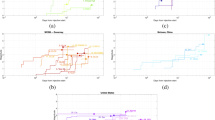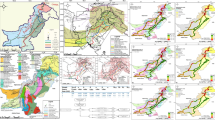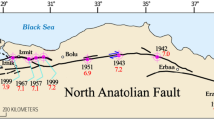Abstract
We describe the design and implementation of a traffic light system (TLS) created for the stimulation phase of a 6.1-km-deep geothermal well in the Helsinki area, Finland. Because of the lack of local seismic data to calibrate the TLS, the TLS thresholds have been proposed on the basis of two parameters: acceptable ground motion levels and probabilities to reach these levels, which were then used to establish TLS magnitudes. A peak ground velocity (PGV) of 1 mm/s associated with a ML ≥ 1 event, or a ML ≥ 1.2 event alone, triggered an Amber alert. A PGV of 7.5 mm/s associated with a ML ≥ 2.1 event triggered a Red alert, where ML was a local “Helsinki” magnitude. Specific thresholds based on PGV and peak ground acceleration were gathered for critical infrastructure sites and related to earthquake magnitudes in a probabilistic way. The implementation of the TLS during the stimulation showed that the selected thresholds were reasonably conservative. Some of the Amber events were reportedly felt or heard, but the public opinion remained very favourable to the project. Measured ground motions were too low to have any impact on the built environment and the stimulation was able to proceed without being impaired by the occurrence of a Red event. Seismic data acquired during the stimulation and lessons learnt are presented and used to revisit the TLS thresholds for potential future stimulations.















Similar content being viewed by others
References
Ader T, Chendorain M, Free M, Saarno T, Heikkinen P, Malin PE, Leary P, Valenzuela S, Kwiatek G, Dresen G, Bluemle F, Vuorinen T (2019) Setting up traffic light system thresholds for geothermal stimulation in Helsinki, Finland. In: 2019 SECED Conference, Greenwich, London, accepted
Bachmann CE (2012) Induced seismicity in Rosemanowes, 16 pp, GEISER report D5.3 – Hazard models for specific test areas
Bommer JJ, Oates S, Cepeda JM, Lindholm C, Bird J, Torres R, Marroquín G, Rivas J (2006) Control of hazard due to seismicity induced by a hot fractured rock geothermal project. Eng Geol 83(4):287–306. https://doi.org/10.1016/j.enggeo.2005.11.002
Bommer JJ (2017) Predicting and monitoring ground motions induced by hydraulic fracturing. OGA-commissioned paper
Bosman K, Baig A, Viegas G, Urbancic T (2016) Towards an improved understanding of induced seismicity associated with hydraulic fracturing. First break 34:61–66
Broccardo M, Mignan A, Wiemer S, Stojadinovic B, Giardini D (2017) Hierarchical Bayesian modeling of fluid-induced seismicity. Geophys Res Lett 44:11,357–11,367. https://doi.org/10.1002/2017GL075251
BSI (1993) Evaluation and measurements for vibration in buildings - Part 2: Guide to damage levels due to groundborne vibrations. BS 7385-2, British Standards Institute
BSI (2008) Guide to evaluation of human response to vibration in buildings - Part 1: Vibration sources other than blasting. BS 6472-1, British Standards Institute
Cuenot N, Dorbath C, Dorbath L (2008) Analysis of the Microseismicity induced by fluid injections at the EGS site of soultz-sous-forêts (Alsace, France): implications for the characterization of the geothermal reservoir properties. Pure Appl Geophys 165:797–828
Diehl T, Kraft T, Kissling E, Wiemer S (2017) The induced earthquake sequence related to the St. Gallen deep geothermal project (Switzerland): fault reactivation and fluid interactions imaged by microseismicity. J Geophys Res Solid Earth, https://doi.org/10.1002/2017JB014473
Douglas J, Edwards B, Convertito V, Sharma N, Tramelli A, Kraaijpoel D, Cabrera BM, Maercklin N, Troise C (2013) Predicting ground motion from induced earthquakes in geothermal areas. Bull Seismol Soc Am 103:1875–1897
Ellsworth WL (2013) Injection-induced earthquakes. Science 341:1225942
Galis M, Ampuero JP, Mai PM, Cappa F (2017) Induced seismicity provides insight into why earthquake ruptures stop. Science Advances 3: eaap7528. Available: https://doi.org/10.1126/sciadv.aap7528
GEISER (2013) D5.3 - Hazard models for specific test areas, Report
Giardini D (2009) Geothermal quake risks must be faced. Nature 462:848–849
Gischig VS, Wiemer S, Alcolea A (2014) Balancing reservoir creation and seismic hazard in enhanced geothermal systems. Geophys J Int 198(3):1585–1598
Grünthal G (2014) Induced seismicity related to geothermal projects versus natural tectonic earthquakes and other types of induced seismic events in Central Europe. Geothermics, https://doi.org/10.1016/j.geothermics.2013.09.009
Guglielmi Y, Cappa F, Avouac JP, Henry P, Elsworth D (2015) Seismicity triggered by fluid injection–induced aseismic slip. Science 348:1224–1226
Haering MO, Schanz U, Ladner F, Dyer BC (2008) Characterisation of the Basel 1 enhanced geothermal system. Geothermics 37:469–495
Halldorsson B, Ólafsson S, Snæbjörnsson JT, Sigurdsson SU, Rupakhety R, Sigbjörnsson R (2012) On the effects of induced earthquakes due to fluid injection at Hellisheidi geothermal power plant, Iceland. In: 15th world conference on earthquake engineering
Hallo M, Oprsal I, Eisner L, Ali MY (2014) Prediction of magnitude of the largest potentially induced seismic event. J Seismol 18:421–431
Hanks TC, Kanamori H (1979) A moment magnitude scale. J Geophys Res 84(B5):2348–2350. https://doi.org/10.1029/JB084iB05p02348
Kwiatek G, Martínez-Garzón P, Dresen G, Bohnhoff M, Sone H, Hartline C (2015) Effects of long-term fluid injection on induced seismicity parameters and maximum magnitude in northwestern part of the Geysers geothermal field. J Geophys Res Solid Earth 120, https://doi.org/10.1002/2015JB012362
Kwiatek G, Saarno T, Ader T, Bluemle F, Bohnhoff M, Chendorain M, Dresen G, Heikkinen P, Kukkonen I, Leary P, Leonhardt M, Malin P, Martínez-Garzón P, Passmore K, Passmore P, Valenzuela S, Wollin C (2019) Controlling fluid-induced seismicity during a 6.1-km-deep geothermal stimulation in Finland. Sci Adv 5(5):eaav7224. https://doi.org/10.1126/sciadv.aav7224
McGarr A (2014) Maximum magnitude earthquakes induced by fluid injection. J Geophys Res Solid Earth 119:1008–1019. https://doi.org/10.1002/2013JB010597
Mignan A, Broccardo M, Wiemer S, Giradini D (2017) Induced seismicity closed-form traffic light system for actuarial decision-making during deep fluid injections. Sci Rep 7:13607. https://doi.org/10.1038/s41598-017-13585-9
Mignan A, Karvounis D, Broccardo M, Wiemer S, Giardini D (2019) Including seismic risk mitigation measures into the Levelized cost of electricity in enhanced geothermal systems for optimal siting. Appl Energy 238:831–850 . ISSN 0306–2619, https://doi.org/10.1016/j.apenergy.2019.01.109
RIL 253-2010 (2010) Rakentamisen aiheuttamat tärinät 2010. Helsinki: Suomen Rakennusinsinöörien Liitto
Lund B, Malm MM, Mäntyniemi PB, Oinonen KJ, Tiira T et al (2015) Evaluating seismic hazard for the Hanhikivi nuclear power plant site, seismological characteristics of the source areas, attenuation of seismic signal, and probabilistic analysis of seismic hazard. F-Consult Ltd, 258 p Saari J (ed)
Shapiro SA, Dinske C, Langenbruch C (2010) Seismogenic index and magnitude probability of earthquakes induced during reservoir fluid stimulations. Leading Edge 29(3):304–309
Shapiro SA, Krüger O S, Dinske C (2013) Probability of inducing given-magnitude earthquakes by perturbing finite volumes of rocks. J Geophys Res Solid Earth 118, https://doi.org/10.1002/jgrb.50264
Schultz R (2018) Bridging gaps in induced seismicity hazard forecasting in Alberta, Canada, presentation at the 36th general assembly of the European seismological commission 6 september 2018, Valletta, Malta
Uski M, Tuppurainen A (1996) A new local magnitude scale for the Finnish seismic network. Seism Source Parameters Microearthquakes Large Events 261:23–37
Van der Elst NJ, Page MT, Weiser DA, Goebel THW, Hosseini SM (2016) Induced earthquake magnitudes are as large as (statistically) expected. J Geophys Res Solid Earth 121:4575–4590. https://doi.org/10.1002/2016JB012818
Westaway R, Younger PL (2014) Quantification of potential macroseismic effects of the induced seismicity that might result from hydraulic fracturing for shale gas exploitation in the UK. Q J Eng Geol Hydrogeol 47(4):333–350. https://doi.org/10.1144/qjegh2014-011
Wiemer S, Kraft T, Trutnevyte E, Roth P (2017) ‘Good practice’ guide for managing induced seismicity in deep geothermal energy projects in Switzerland. In: Proceedings from the 20th EGU General Assembly held 4-13 April, 2018, Vienna, Austria, pp 15021
Author information
Authors and Affiliations
Corresponding author
Additional information
Publisher’s note
Springer Nature remains neutral with regard to jurisdictional claims in published maps and institutional affiliations.
Rights and permissions
About this article
Cite this article
Ader, T., Chendorain, M., Free, M. et al. Design and implementation of a traffic light system for deep geothermal well stimulation in Finland. J Seismol 24, 991–1014 (2020). https://doi.org/10.1007/s10950-019-09853-y
Received:
Accepted:
Published:
Issue Date:
DOI: https://doi.org/10.1007/s10950-019-09853-y




